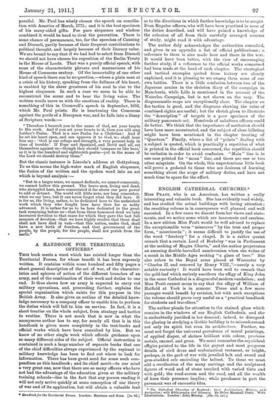A HANDBOOK FOR TERRITORIAL
OFFICERS.*
This book meets a want which has existed longer than the Territorial Forces, for whose benefit it has been expressly written. It contains within some hundred and fifty pages a short general description of the art of war, of the character- istics and spheres of action of the different branches of an army, and of the combination of their work and duties to one end. It thus shows how an army is expected to carry out military operations, and, proceeding further, explains the special organisation which exists for this purpose in the British Army. It also gives an outline of the detailed know- ledge necessary to a company officer to enable him to perform the duties which will fall to him on service. In fact, it is a short treatise on the whole subject, from strategy and tactics to routine. There is not much that is new in what the anonymous author has to say, for nearly all that is in this handbook is given more completely in the text-books and official works which have been consulted by him. Bat we know of no other single work which affords guidance upon so many different sides of the subject. Official instruction is contained in such a large number of separate books that one of the chief difficulties always experienced by the aspirant to military knowledge has been to find out where to look for information. There has been great need for some such com- pendium as this handbook ; and its chief merit—to our mind a very great one, now that there are so many officers who have not had the advantage of the education given at the military training schools—lies in the fact that any person reading it will not only arrive quickly at some conception of our theory of war and of its application, but will obtain a valuable lead • Handbook for the Territorial Forces. London: Harrison and Bons. [Is. 65.] as to the directions in which further knowledge is to be sought Even Regular officers, who will have been practised in most of the duties described, and will have gained a knowledge of the cohesion of all from their carefully arranged courses of study, might read it with advantage.
The author duly acknowledges the authorities consulted, and gives in an appendix a list of official publications ; a reference to them is also made here and there in the text. It would have been better, with the view of encouraging further study, if a reference to the official works concerned had been made at the head of each chapter. The strategical and tactical examples quoted from history are clearly explained, and it is pleasing to see among them some of our own battles. There is a little confusion between two of the Japanese armies in the skeleton diary of the campaign in. Manchuria, while Lille is mentioned in the account of the Waterloo Campaign, but is not shown on the map. The diagrammatic maps are exceptionally clear. The chapter on fire tactics is good, and the diagrams showing the value of combined sights are useful; but the sketch given to illustrate the " description " of targets is a poor specimen of the military panoramic art. Hundreds of subaltern officers could do better. We think that the importance of sanitation should have been more accentuated, and the subject of close billeting might have been mentioned in the chapter treating of "Quarters." Finally, where a list of " points " dealing with a subject is quoted, which is practically a repetition of what is printed in the official book concerned, the repetition should be verbatim in order to avoid confusion. "Main" line is in one case printed for " mean" line, and there are one or two other misprints. On the whole, this unpretentious little book will prove a godsend to those who are desirous of learning something about the scope of military duties, and have not much time to spare for the effort.










































 Previous page
Previous page